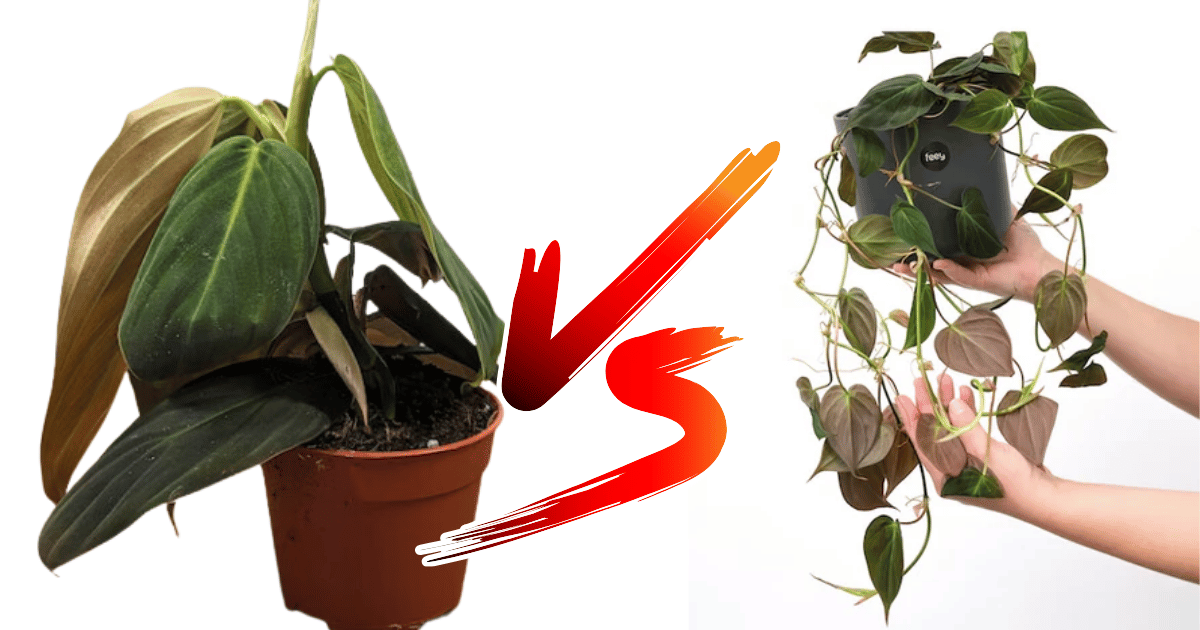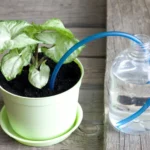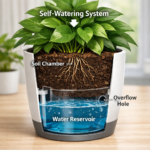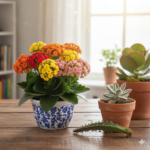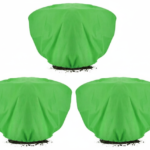Philodendrons are beloved houseplants, celebrated for their lush foliage and low-maintenance nature. Among the diverse varieties, Philodendron Gigas and Philodendron Melanochrysum stand out for their unique and striking appearances. Choosing between these two can be a delightful yet challenging task for plant enthusiasts. Philodendron Gigas is known for its large, velvety leaves that can add a tropical feel to any space. At the same time, Philodendron Melanochrysum captivates with its dark, glossy leaves adorned with vibrant venation. Both plants require similar care but offer different aesthetic appeals and growth patterns.
In this article, we’ll explore the key differences and similarities between Philodendron Gigas and Melanochrysum, including their care requirements, growth habits, and ideal living conditions. Whether you want to expand your indoor jungle or start your plant collection, understanding these two Philodendrons will help you decide which best suits your home and lifestyle.
About Philodendron Gigas and Melanochrysum
Philodendron Gigas and Philodendron Melanochrysum are popular varieties within the Philodendron genus, known for their impressive foliage and appealing aesthetics.
Philodendron Gigas is admired for its large, velvety leaves that can grow to significant sizes. They often display a deep green hue with a soft texture and unique elongated shape, making this plant a standout in any collection. Originating from the tropical rainforests of Central and South America, Gigas thrives in high humidity and indirect light, making it an excellent choice for indoor environments that mimic its natural habitat.
On the other hand, Philodendron Melanochrysum, also known as the “Black Gold Philodendron,” is noted for its dark, glossy leaves with prominent, golden veining. This plant exudes elegance and sophistication, often becoming the focal point in a room. Native to the rainforests of Colombia and Ecuador, Melanochrysum also prefers humid conditions and dappled sunlight.
Origins of Philodendron Gigas and Melanochrysum
To provide a more precise comparison between the origins and background of Philodendron Gigas and Philodendron Melanochrysum, the following table summarizes their native habitats and discovery details:
Philodendron Gigas
- Native Habitat: Found in the rainforests of Central and South America, Philodendron Gigas grows in the shaded understory, where it receives filtered sunlight. It thrives in high humidity and stable temperature conditions, which support its growth and the development of its large, velvety leaves.
- Discovery and Popularity: Compared to other Philodendron species, Philodendron Gigas was discovered relatively recently. Its distinctive foliage quickly made it a favorite among plant collectors, particularly for indoor gardens. The plant’s aesthetic appeal and adaptability to indoor environments have contributed significantly to its popularity.
Philodendron Melanochrysum

- Native Habitat: Native to the rainforests of Colombia and Ecuador, Philodendron Melanochrysum grows as an epiphyte, often attaching itself to trees. This growth habit allows it to access the nutrients and moisture from the air and rain, thriving in warm, humid conditions with indirect light.
- Discovery and Popularity: Melanochrysum was discovered during botanical explorations in the rich biodiversity of South American rainforests. It gained attention for its unique “black gold” leaves, which feature dark green to almost black foliage with striking golden venation. This plant’s distinctive appearance and relatively simple care requirements make it a desirable addition to any plant collection.
Physical Characteristics
Leaf Structure and Size
Philodendron Gigas and Philodendron Melanochrysum are admired for their striking leaves but differ significantly in leaf structure and size.
Philodendron Gigas Leaves
Philodendron Gigas is renowned for its large, velvety leaves. These leaves are deep green with a slight sheen and are notably soft. The leaves can grow quite large, often reaching lengths of 2 to 3 feet in ideal conditions. They are elongated with a slight heart shape and typically have a somewhat wavy margin. The velvety texture is due to tiny hairs covering the leaf surface, giving it a unique, plush appearance.
Philodendron Melanochrysum Leaves
Philodendron Melanochrysum, on the other hand, is known for its dark, glossy leaves. The leaves are also significant but are more elongated and narrower than Gigas. They feature a striking contrast between the deep, almost black-green color and the bright golden venation that runs through them. This venation becomes more pronounced as the leaves mature. The texture of Melanochrysum leaves is smoother and glossier, lacking the velvety feel found in Gigas. The leaves can grow up to 2 feet long, with some variations depending on the plant’s environment and care.
Growth Pattern
Climbing Habits
Both Philodendron Gigas and Melanochrysum are nature climbers, often called vining plants. They use aerial roots to attach themselves to surfaces like tree trunks or other support structures. They can be trained to climb moss poles, trellises, or other supports in indoor environments. This climbing habit is a natural adaptation that helps the plants reach for light in their native tropical forest habitats.
Philodendron Gigas tends to have a more robust, bushier growth if allowed to trail, while Melanochrysum often has a more streamlined appearance with longer internodes. Both plants can grow quite tall, mainly with a suitable climbing structure. Indoors, they can be managed to maintain a desired shape and size through pruning and training techniques.
Can both these plants be grown outdoors and indoors?
Yes, both Philodendron Gigas and Philodendron Melanochrysum can be grown both indoors and outdoors, but there are specific conditions to consider for each environment.
Indoors
These Philodendrons are popular houseplants indoors due to their striking foliage and relatively easy care requirements. They thrive in bright, indirect light and can tolerate lower light levels, although their growth may slow. Maintaining high humidity levels indoors is essential, especially in climates with dry air. Regular watering is needed, but care must be taken to avoid overwatering, which can lead to root rot. Indoors, they can be trained to climb on moss poles or trellises, mimicking their natural climbing habit.
Outdoors
Outdoors, these plants can grow well in warm, tropical, or subtropical climates where temperatures do not drop below 55°F (13°C). They prefer shaded or partially shaded areas protected from direct sunlight, which can scorch their leaves. In outdoor settings, they can climb trees or other structures, using their aerial roots to attach themselves. It is crucial to provide a humid environment similar to their natural rainforest habitat to keep them healthy. In areas with cooler climates, these plants should be brought indoors or protected during cold weather to prevent damage.
Are Philodendron Gigas and Melanochrysum Safe for Pets?
No, neither Philodendron Gigas nor Philodendron Melanochrysum is safe for pets. Like many plants in the Araceae family, they contain calcium oxalate crystals. If ingested, these crystals can cause irritation and swelling in pets’ mouths, throats, and digestive tracts, leading to symptoms such as drooling, vomiting, difficulty swallowing, and, in severe cases, more serious health issues.
Pet owners must keep these plants out of reach of curious pets, such as cats and dogs, to prevent accidental ingestion. If you suspect your pet has ingested any part of a Philodendron plant, seeking veterinary attention immediately is crucial to ensure proper care and treatment. Pet owners looking to maintain a safe environment while enjoying these beautiful plants should consider placing them in areas inaccessible to pets, such as on high shelves or in rooms pets cannot access.
To know more read:Purple Waffle Plant’s Toxicity to Cats: Safety Tips
Care Requirements
Light and Temperature
Optimal Lighting
Philodendron Gigas and Melanochrysum both thrive in bright, indirect light. They can tolerate low light conditions, but their growth will be slower, and their leaves may not develop as vibrantly. Direct sunlight should be avoided as it can scorch the leaves, causing brown spots or fading.
Temperature Preferences
These plants prefer warm temperatures, ideally between 65°F and 80°F (18°C to 27°C). They can tolerate slightly cooler temperatures but should not be exposed to conditions below 55°F (13°C), which can cause stress and slow growth. Both species thrive in consistent temperatures and should be kept away from drafts, air conditioners, and heaters that cause temperature fluctuations.
Watering and Humidity
Watering Needs
Philodendron Gigas and Melanochrysum enjoy consistent moisture but dislike sitting in waterlogged soil. It’s best to water them when the top inch of soil feels dry. Overwatering can lead to root rot, a common issue for these plants, so ensure the pot has good drainage and never let the plant sit in standing water.
Humidity Levels
Both plants love high humidity levels, ideally above 60%. If your indoor environment is dry, especially during winter, consider using a humidifier or placing a tray of water near the plants to increase humidity. Alternatively, misting the leaves regularly can also help maintain moisture levels.
Soil and Fertilization
Ideal Soil Mix
A well-draining, rich potting mix is ideal for both Philodendron Gigas and Melanochrysum. A mix containing peat, perlite, and orchid bark is often recommended to ensure proper drainage and aeration. This type of soil mimics their natural epiphytic conditions, allowing the roots to breathe and preventing water retention.
Fertilization Tips
Regular feeding during the growing season (spring and summer) can promote healthy growth. Use a balanced, water-soluble fertilizer diluted to half-strength every 4-6 weeks. Avoid over-fertilizing, as it can lead to salt build-up in the soil and damage the plant.
Propagation Techniques
Propagating Philodendron Gigas
Stem Cuttings
Select a healthy section of the plant with at least t:
- Select to propagate Philodendron Gigas through stem cuttings.
- Cut below a node and remove the lower leaves.
- lace the cutting in water or a well-draining soil mix.
- nsure it receives high humidity and indirect light.
oots typically develop in a few weeks.
Air Layering
Air layering involves making a small cut on a healthy stem, then wrapping it with moist sphagnum moss and plastic wrap to encourage root growth. Once roots are visible, the stem can be cut below the new root system and potted up.
Propagating Philodendron Melanochrysum
Stem Cuttings
The process for propagating Melanochrysum through stem cuttings is similar to Gigas. Choose a stem with at least one or two nodes, cut below a node, and place the cutting in water or soil. High humidity and indirect light are crucial for successful rooting.
Air Layering
Air layering is also an effective method for Melanochrysum. Follow the same procedure as with Gigas, ensuring that the sphagnum moss remains moist and the wrapped section is kept warm and humid until roots form.
Common Pests and Problems
Pests to Watch Out For
Spider Mites
Spider mites are tiny pests that can infest Philodendrons, particularly in dry conditions. They suck sap from the leaves, causing yellow spots and a stippled appearance. Regular misting and maintaining high humidity can help prevent spider mite infestations. If detected, washing the leaves with water and using insecticidal soap can control the problem.
Mealybugs
Mealybugs are another common pest for Philodendrons, identifiable by their cotton-like appearance. They feed on the plant’s sap, weakening it and causing yellowing leaves. Removing mealybugs manually with a cotton swab dipped in alcohol or using insecticidal soap can help manage infestations.
Disease Prevention
Root Rot
Root rot is a serious issue caused by overwatering and poor drainage. Symptoms include yellowing leaves and a foul odor from the soil. To prevent root rot, ensure proper drainage and avoid overwatering. If root rot occurs, repotting the plant with fresh soil and trimming affected roots may save the plant.
Leaf Spot
Leaf spot diseases, caused by bacteria or fungi, can appear as dark spots on the leaves. To prevent these diseases, avoid overhead watering and remove any affected leaves. Ensuring good air circulation around the plant also helps prevent fungal growth.
Which is Right for Your Home?

Choosing between Philodendron Gigas and Philodendron Melanochrysum depends on your aesthetic preferences and the environment you can provide. Philodendron Gigas might be the better choice if you prefer a plant with large, velvety leaves and a robust growth habit. It’s slightly hardier and can adapt to a broader range of conditions.
On the other hand, if you’re looking for a plant with dark, glossy leaves and striking golden veins, Philodendron Melanochrysum offers an exotic, sophisticated appeal. It does well in high humidity and requires consistent care to maintain its beautiful foliage.
Both plants require bright, indirect light and high humidity to thrive, so consider your home’s lighting and humidity levels. For homes with pets, it’s crucial to keep these plants out of reach, as they are toxic if ingested. Ultimately, either plant can be a stunning addition to your indoor space, bringing a touch of tropical elegance and lush greenery.
FAQs
Which plant is more accessible to care for?
Both Philodendron Gigas and Melanochrysum require similar care, including bright, indirect light and high humidity. However, Philodendron Gigas may be more accessible for beginners due to its hardier nature and greater tolerance for varying conditions. Melanochrysum’s delicate leaves can be more sensitive to humidity levels and light conditions.
Can these plants be grown outdoors?
Both Philodendron Gigas and Melanochrysum can be grown outdoors in warm, tropical, or subtropical climates. They thrive in shaded or partially shaded areas, protected from direct sunlight. In cooler climates, they should be brought indoors or protected during colder months to prevent damage.
How fast do these plants grow?
The growth rate of Philodendron Gigas and Melanochrysum can vary depending on the environment and care provided. Under optimal conditions with proper light, humidity, and nutrients, these plants can grow moderately fast, producing several new leaves per growing season. However, growth may slow down in less ideal conditions.
Are they safe for pets?
No, neither Philodendron Gigas nor Melanochrysum are safe for pets. They contain calcium oxalate crystals, which can cause irritation and swelling in the mouth, throat, and digestive tract if ingested by pets. It’s essential to keep these plants out of reach of curious animals.
What are the ideal conditions for flowering?
Philodendron Gigas and Melanochrysum rarely flower indoors. They need optimal conditions, including high humidity, consistent warmth, and indirect light, to encourage flowering. Flowering is more common in mature plants grown outdoors in natural or similar environments, where they receive more stable conditions that mimic their native habitats.
Conclusion
In conclusion, Philodendron Gigas and Philodendron Melanochrysum are captivating plants with unique characteristics, making them excellent choices for plant enthusiasts. While Gigas offers large, velvety leaves, Melanochrysum boasts striking, dark foliage with golden veins. Both can thrive indoors and outdoors, given proper care, including the right lighting, humidity, and temperature conditions. Whether seeking a lush, tropical look or a sophisticated, exotic appeal, these Philodendrons provide stunning options to enhance your plant collection and indoor decor.

